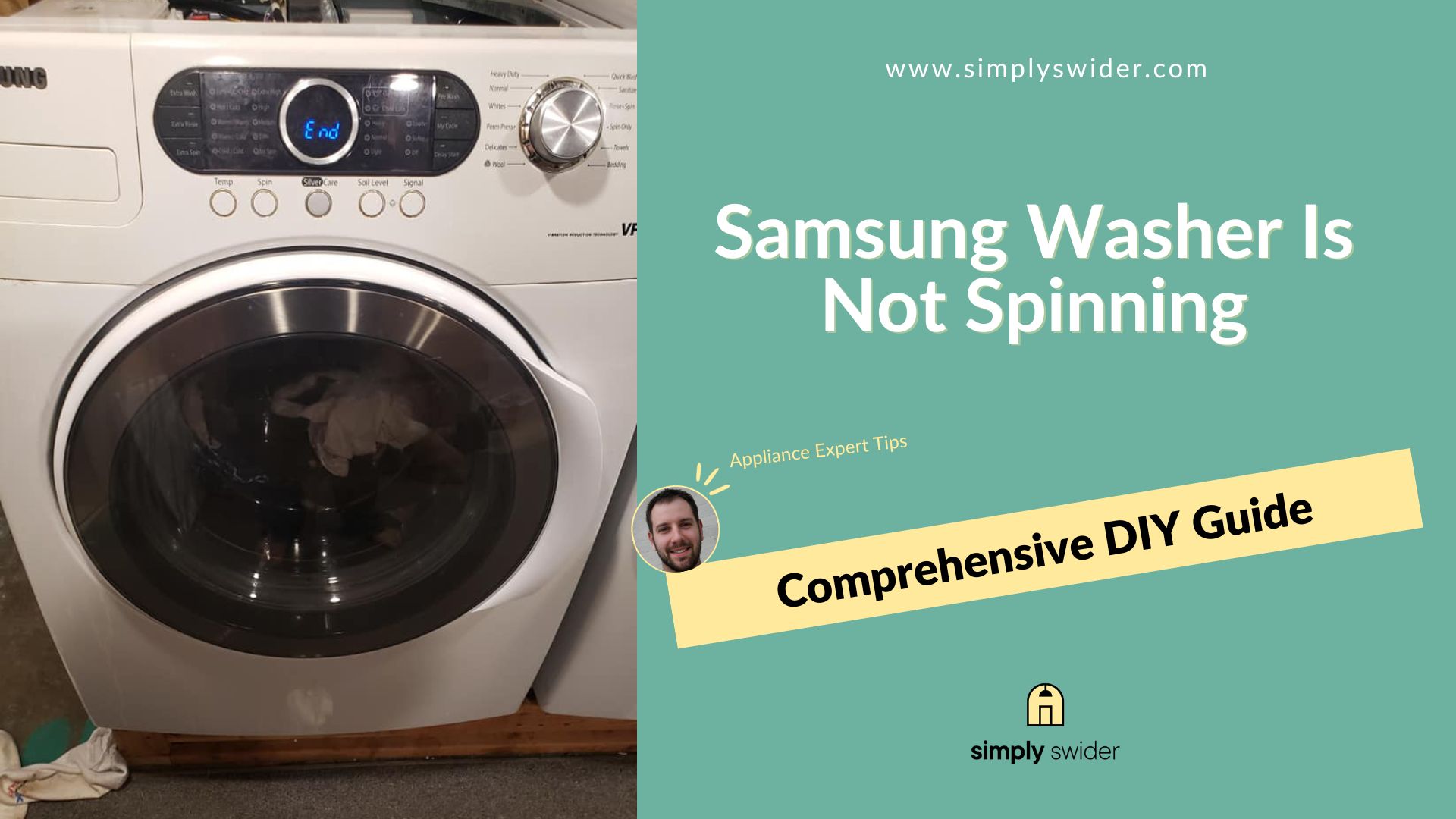Over the years, one issue has consistently made its way to my workshop: “Jason, my Samsung Washer Is Not Spinning!” Just last week, a longtime client reached out with this exact problem, having trusted his Samsung for the past three years.
Here’s the thing:
I’ve encountered this scenario countless times, and with each fix, I’ve gathered invaluable insights.
Now:
Partnering with Hank Williams, a seasoned appliance technician from Dallas, Texas, I’m about to share a comprehensive guide to resolving this spinning dilemma.
Trust me, I’ve got solutions that work. Ready to dive in? Let’s get that washer spinning again!
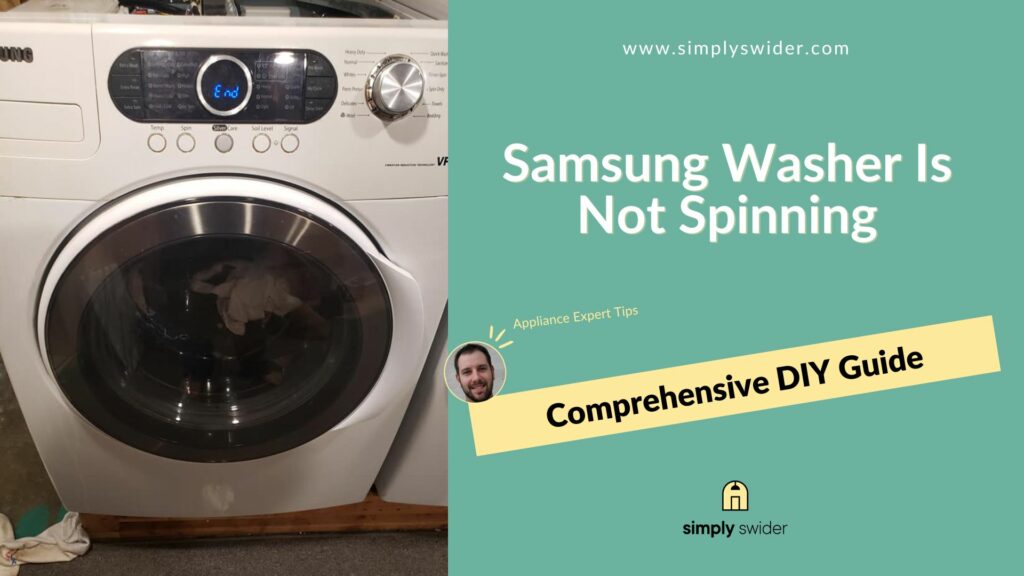
Table of Contents
Why Is Your Samsung Washer Not Spinning?
A few potential issues come to mind when I think about a Samsung washer that won’t spin. These include an unbalanced washer, a malfunctioning door lock mechanism, and a damaged drive belt. In the worst-case scenario, you may be dealing with a faulty drive motor needing replacement.
In due course:
I will discuss each of these four potential causes of the spin failure, covering their identification and resolution.
So, unplug your washer, turn off the water faucets, roll up your sleeves, and let’s troubleshoot this problem!
4 Reasons Why & How to Fix Them
| Commonly Affected Parts | Estimated Cost |
|---|---|
| Lid switch | $20 – $70 |
| Door lock latch | $30 – $80 |
| Drive belt | $10 – $30 |
| Drive motor | $75 – $200 |
1. Unbalanced Washer
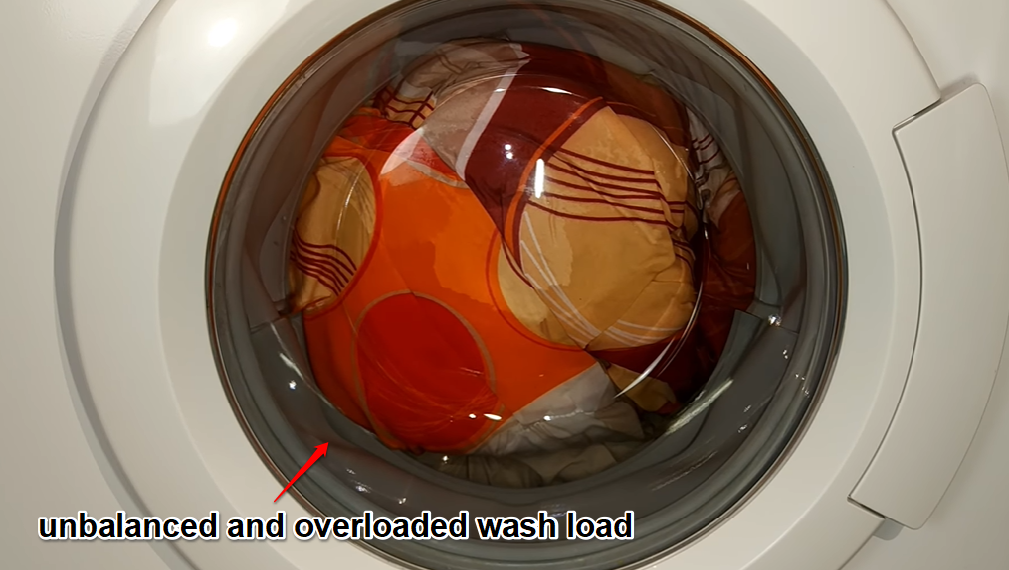
Problem:
To be quite frank, dunking your clothes haphazardly into your washer just won’t cut it anymore.
It is likely the reason why you are here, seeking repair guidance for your Samsung washer that won’t spin.
You see:
Whether the clothes have been piled on one end or the washer has been overloaded, an unbalanced washer won’t spin freely.
The thing is:
When you load too many clothes into your washer, the drum will be unable to turn because of the excess weight.
Moreover, if you use an agitator washer, an unevenly spread load will hinder it from twisting the clothes around.
That’s not all:
Your washer may also be placed on uneven ground, tipping it at an uncomfortable angle and creating an imbalance in the tub.
Identification:
Most Samsung washers have a sensor that can detect an unlevel washer or unevenly distributed load.
You should see a Ub, Ur, or U6 error code on the display when this happens.
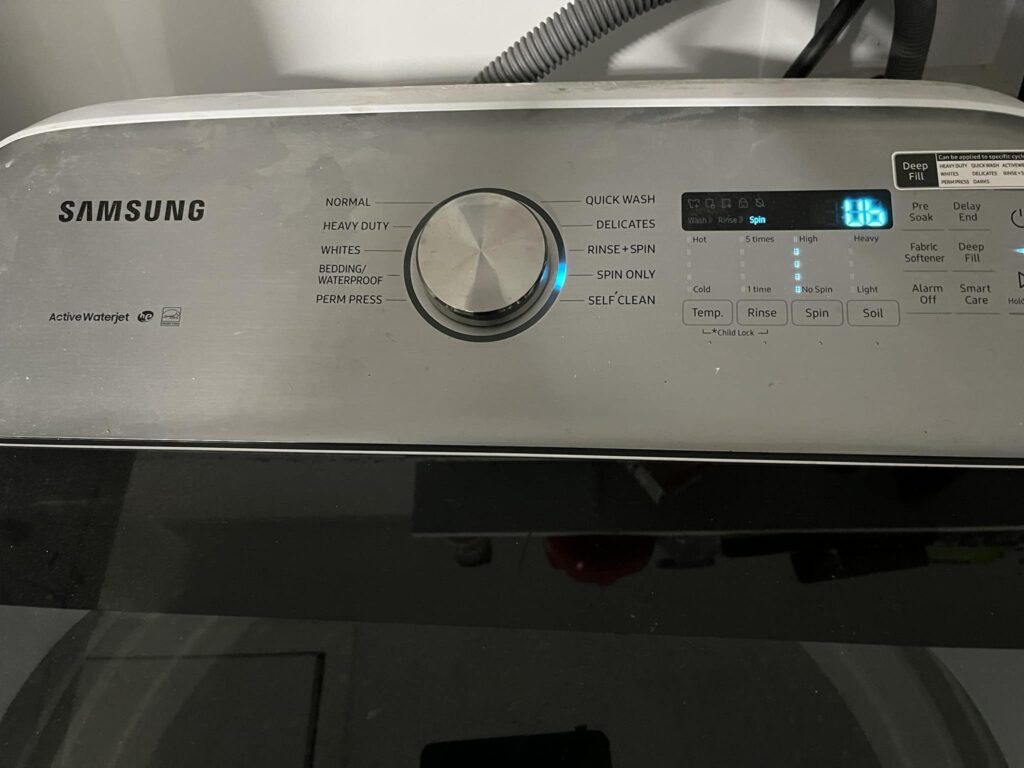
Now:
This Reddit user had the exact experience with their Samsung WA50M7450AW/A4 washer. The machine refused to run a spin cycle and threw the Ur and Ub error codes.
Hank adds: “Unusual thumping, thudding, or banging are tell-tale sounds indicating a lopsided washer. Also, you may notice your Samsung washer shaking violently.”
Further, you can place a spirit level on your washer to check if it stands on a level surface.
Solution:
First, if you receive an error code, you must reset it. To do that, switch off your washer and disconnect it from the outlet.
Wait about a minute, then power it back on.
Now:
Resolving this usage error doesn’t require much. Primarily, you have to adopt the proper loading technique with your washer.
Here’s how to do that:
- Step 1: Spread your laundry around the drum’s edges, making sure the center is visible.
- Step 2: If bulky items are in a load, distribute their weight around the tub, ensuring one side is not overpopulated with heavy items.
- Step 3: In the event that you’ve got just one heavy item to wash, ensure you include more items in the wash for balance.
Finally:
Examine the ground your washer is placed on. If it is unlevel, move it around or adjust the washer’s leveling legs to rectify the imbalance.
2. Malfunctioning Lid Switch or Door Lock Latch
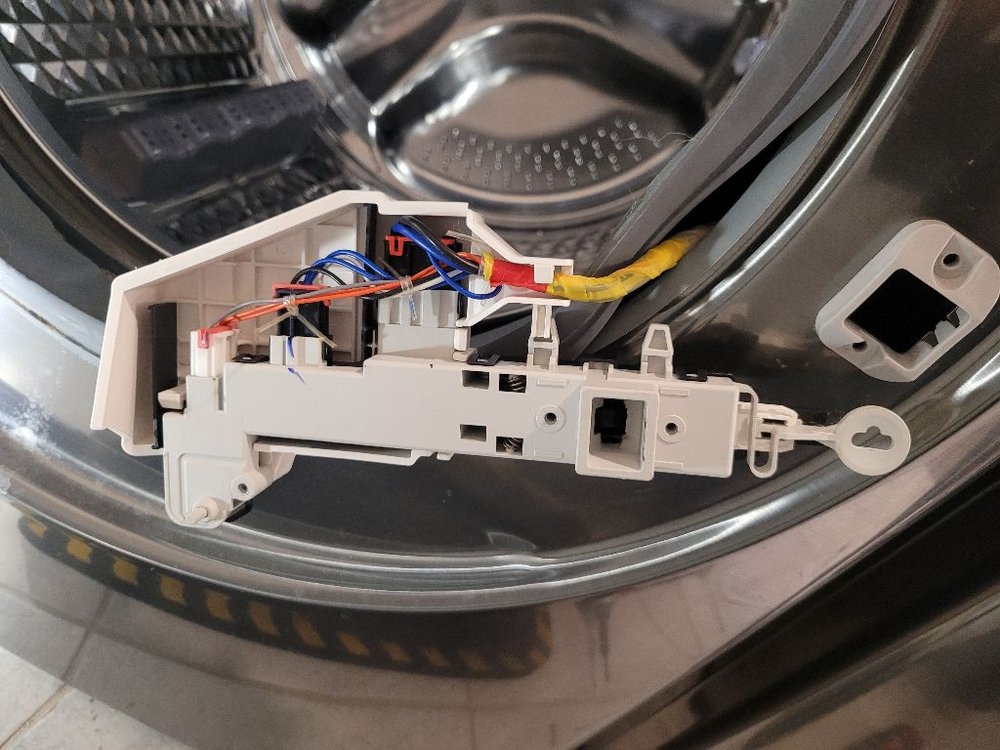
| Part | Lid Switch | Door Lock Latch |
| Location | The lid switch can be found beneath the lid of a top-load washer. | The door lock latch is located inside the front-load washer’s door frame. |
| Ease of troubleshooting | Moderate | Moderate |
| Cost | $20 – $70 | $30 – 80 |
| Repairable | No | No |
Problem:
Washers are usually equipped with a door-locking safety mechanism that prevents the washer from agitating or spinning when not activated. Your Samsung washer is not exempt.
You see:
The lid switch is the door-locking mechanism if you have a top-load Samsung washer. And for a front-load Samsung washer, the door lock latch bears that responsibility.
As such:
If your Samsung washer won’t budge during a cycle, the door lock mechanism might be faulty.
When this happens, your washer will not spin because it has trouble detecting whether the door or lid is securely closed.
Now:
This is a pretty common cause of the defect. Judging from the feedback from the members of our Facebook community, it is moderately simple to identify and rectify.
Identification:
To determine a bad lid switch or door lock latch, you must pay close attention to how the door interacts with the washer.
Hank says: “Listen for a clicking or latching sound when you close the door or lid. If you hear it, you’re lucky; if not, you may need to replace the door lock or lid switch in your washer.”
Furthermore:
Like the previous defect, your Samsung washer has error codes to point you in the right direction. The DC, DC1, dE, and dE1 error codes typically represent door lock issues.
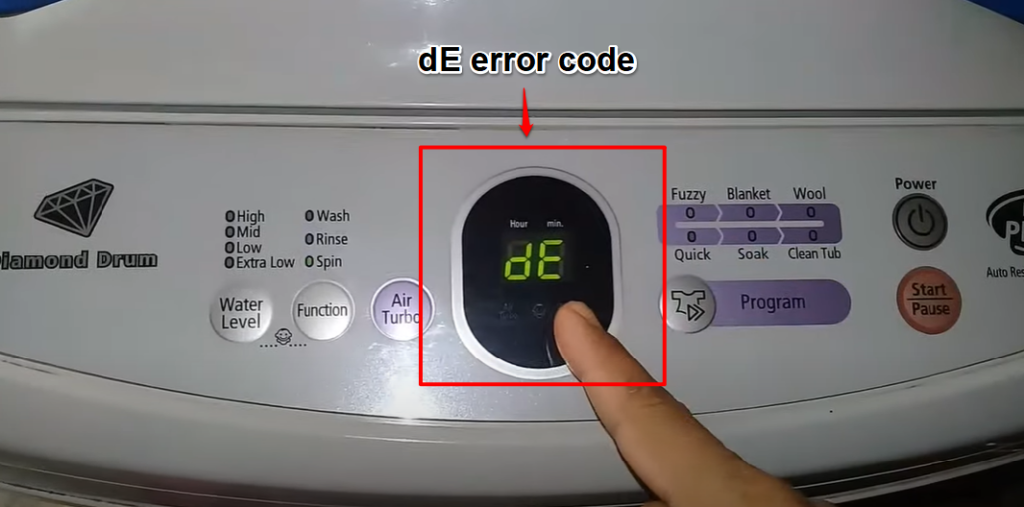
To illustrate:
This Reddit user’s 5-year-old Samsung WF42H5200AF/A2 front load washer started throwing the DE error code.
They recognized that it was a door lock issue and immediately replaced the door lock latch.
Solution:
Now that you’ve identified an issue with the door-locking mechanism, what’s next? We’ve got to loosen some screws and get fixing.
If you own a top-load washer, follow these steps to test and replace your defective lid switch:
- Step 1: Remove the screws securing the access panel.
- Step 2: Slide a putty knife under the lid and lift it to release the clips.
- Step 3: Inspect the switch for loose electrical connections and physical damage.
- Step 4: If the wiring is appropriate, test the lid switch for electrical continuity with a multimeter.
- Step 5: If it fails this test, you must immediately detach it and replace it with a new component.
For front-load users, follow these steps to test your door lock latch.
- Step 1: Locate the door lock latch in the door framing and inspect it for damage.
- Step 2: Unthread the screws and detach it from the door frame if it is damaged.
- Step 3: Replace it with a new door lock latch.
3. Loose or Broken Drive Belt
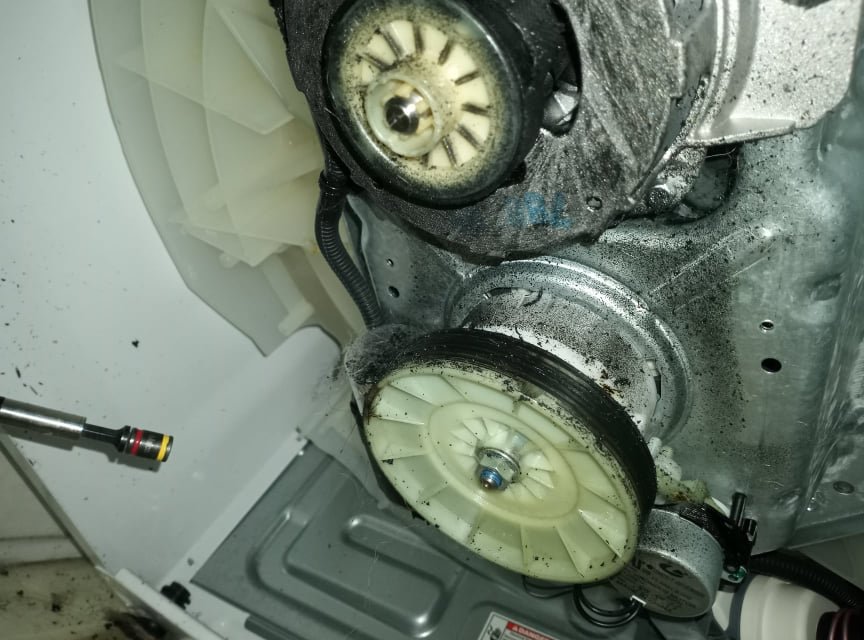
| Part | Drive belt |
| Location | It is found behind the back access panel and is connected to the motor and wash drum. |
| Ease of troubleshooting | Easy |
| Cost | $10 – $30 |
| Repairable | Yes – If it slipped off the drum or pulley. No – If it is stretched, worn, or broken. |
Problem:
If you didn’t know already, the drive belt connects the drive motor to the wash drum. The purpose of this connection is to rotate the wash drum, facilitated by the drive pulley, during a cycle.
Unfortunately:
Like all washer parts, the drive belt is prone to wear and tear and will eventually become slack or break completely.
When this happens, your Samsung washer will not spin.
Identification:
To determine if the drive belt is faulty, listen carefully for the sound of the motor running. If you can hear it and the tub won’t spin, the drive belt has an issue.
Hank says: “Next, use your hand to turn the wash drum manually. If it spins freely without mild resistance, the drive belt has probably slipped off or broken.”
You see:
For this Reddit user, the Samsung technician suggested that their top-loading WA45T3200AW/A4 washer was not spinning because of a faulty belt or bearings.
And Hank and I agree with him.
In my opinion:
Both parts could cause the defect, as faulty bearings have a reputation for producing the observed grinding noise.
On the other hand, given that the drum is spinning freely manually and the motor is functional, the drive belt is also culpable.
Ultimately:
The best way to identify a broken drive belt is by performing a physical examination of the part.
Remove the back panel, check for signs of wear, weakness, or cracks in the belt, and ensure it hasn’t accidentally slipped off.
Solution:
Once you’ve confirmed the drive belt is loose or broken, you must replace it with a new one.
After discarding the defective drive belt, fit the replacement belt carefully onto the drive pulley and reattach the back access panel.
Hank chimes in: “You may find the replacement belt too tight for your washer. In such an event, you can simply step on one end of the belt and pull upwards to stretch it out a bit.”
4. Defective Drive Motor
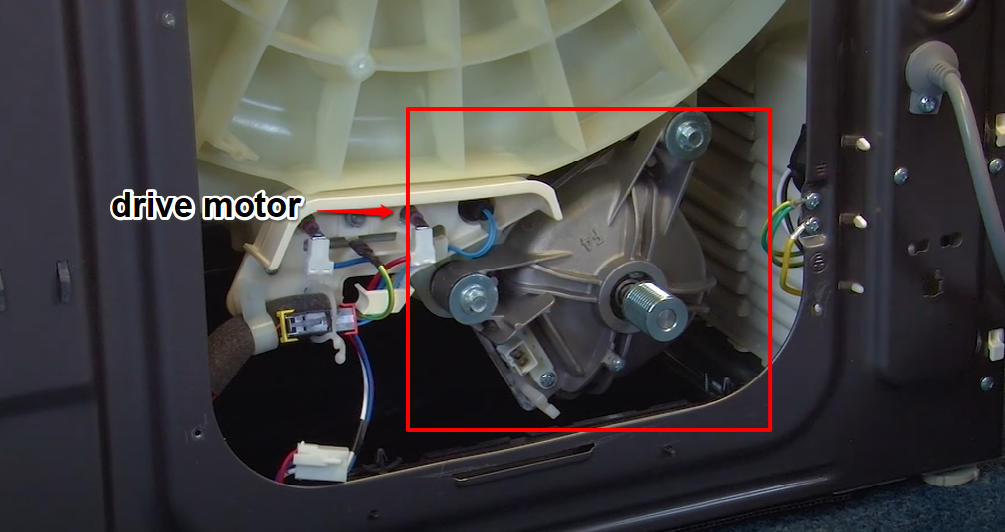
| Part | Drive motor |
| Location | It is located behind the machine, at the bottom of the washer, and is attached to the drive pulley. |
| Ease of troubleshooting | Difficult |
| Cost | $75 – $200 |
| Repairable | No |
Problem:
Once you’ve exhausted your other options, you’ve got to pull out the big guns.
Troubleshooting a faulty motor is a last resort repair, one which Hank believes should ideally be handled by a professional.
You may be wondering:
How could a bad drive motor affect my Samsung washer’s spinning ability?
Well, the motor is the core component facilitating the spinning action. It powers the drive pulley, which draws the belt that spins the wash drum.
As such:
If the drive motor fails or any of its components are defective, your Samsung washer will not spin.
Identification:
Like this Reddit user suggested, you should run diagnostics on your washer to confirm that the motor is indeed faulty.
Hold down “Delay End” and “Option” to put your washer in diagnostics mode for about 10 seconds.
According to Samsung:
To confirm a motor issue, you should look out for the 3C, 3E, 3E1, 3E2, 3E3, and 3E4 error codes.
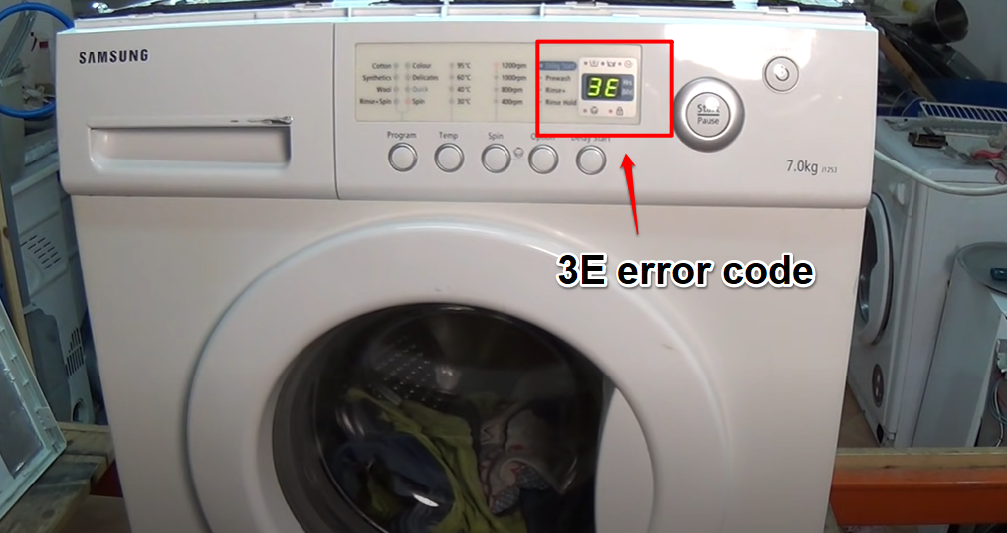
Generally, these codes indicate that any motor components or the motor itself could be damaged, but your user manual should tell you more.
Here’s a great example:
This Reddit user’s 6-year-old Samsung WF80F5E0W4W/EU EcoBubble washer refused to spin, and after running diagnostics, it threw a 3E error code.
Sure enough, after some examination, they discovered that the motor’s carbon brushes were damaged.
In addition:
Hank mentions that strange humming or buzzing sounds while the washer refuses to spin points at a motor defect.
Solution:
The truth is that replacing a motor in a washer is extremely technical and more expensive than most repairs.
That is why I agree with Hank when he says that an appliance technician would best handle such a repair.
Nonetheless:
If you are up to the task, then by all means, give it a shot. Ensure you use the appropriate equipment, wear protective gear, and employ safety measures before troubleshooting.
Follow these steps to test and replace your defective motor:
- Step 1: Detach the access panel at the back of the washer.
- Step 2: Locate the drive motor at the bottom and unscrew the mounting bolts.
- Step 3: Inspect it for any signs of physical damage.
- Step 4: Test the motor for electrical continuity with a multimeter.
- Step 5: If the results are negative, replace the drive motor.
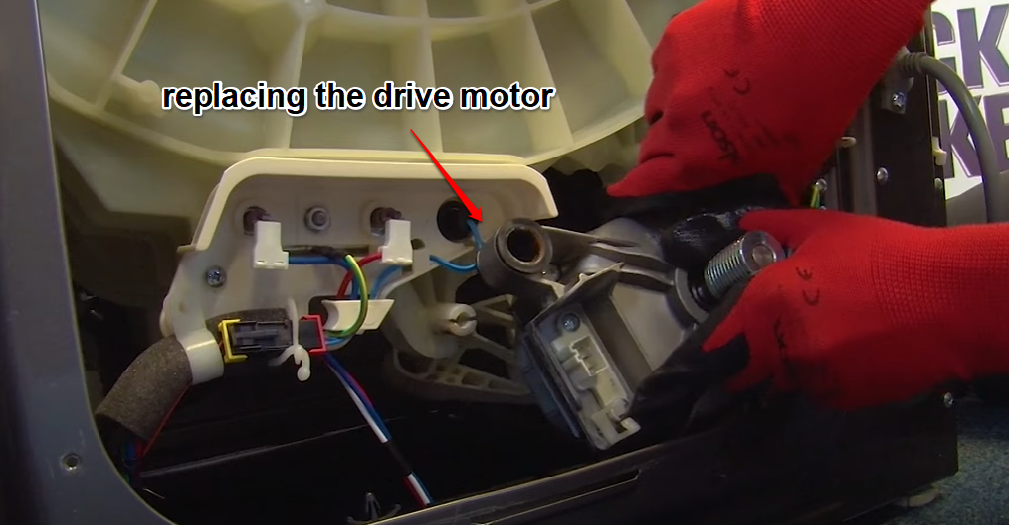
Hank advises: “You should also check for faults in the motor components like the coupling or carbon brushes. Sometimes, these components could also stop your Samsung washer from spinning.”
8 Samsung Washer Models Most Affected by the Spinning Issue
Look:
Specific Samsung washer models have a reputation for their vulnerability to spinning problems.
What kind of guide would I be if I didn’t make a compilation of these models and the defect causing their spinning malfunction?
Here you go!
| Model Number | Model Name | Model-Specific Reason |
|---|---|---|
| WF350ANW/XAA-04 | Samsung Front Load Washer | Malfunctioning door lock latch |
| WF80F5E0W4W/EU | Samsung EcoBubble Front Load Washer | Defective drive motor |
| WA45T3200AW/A4 | Samsung Top Load Washer | Loose or broken drive belt |
| WF218ANW/XAA | Samsung Front Load Washer | Malfunctioning door lock latch |
| WA52A5500AW | Samsung Top Load Washer | Malfunctioning lid switch |
| WF42H5200AF/A2 | Samsung Front Load Washer | Malfunctioning door lock latch |
| WA50M7450AW/A4 | Samsung Top Load Washer | Unbalanced washer |
| WA50R5200AW/US | Samsung Active WaterJet Top Load Washer | Defective drive motor |
Conclusion
Listen up:
Before you dial up a technician for that spinning issue with your Samsung washer, give DIY a shot. Key problems to watch for include unbalanced loads, faulty lid switches or door latches, and busted drive motors.
Takeaway:
Follow the guidance, and you should be on track. Still stuck? Hit up our “Ask the Expert” feature.
Hank’s two cents: “Regular service and upkeep keep washer defects at bay.“
Lastly:
Gave it a try? Share your story in the comments. Your journey might help someone else out!

